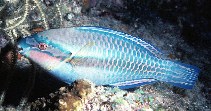| Family: |
Scaridae (Parrotfishes), subfamily: Scarinae |
| Max. size: |
35 cm TL (male/unsexed) |
| Environment: |
reef-associated; marine; depth range 3 - 25 m |
| Distribution: |
Western Atlantic: Bermuda, Florida (USA), Bahamas, and northeastern Gulf of Mexico to northern South America; throughout the Caribbean (Ref. 3802, 13628). Range probably extends to Brazil (Ref. 13628). |
| Diagnosis: |
Dorsal spines (total): 9-9; Dorsal soft rays (total): 10-10; Anal spines: 3-3; Anal soft rays: 9-9. White stripe above upper dark stripe ends at gill opening; upper and lower caudal margins pale (Ref. 26938). Terminal phase males are blue-green and orange, chest and head pink below a green band at lower edge of eye; median fins with blue borders, the broad central parts orange with linear blue markings (Ref. 13442). |
| Biology: |
Found over shallow, clear waters, generally over Thalassia beds (Ref. 13628). Also found rocky or coral areas (Ref. 13628). A schooling species. Feeds on plants. A protogynous hermaphrodite (Ref. 55367). Super males spawn individually with striped females, while sexually mature males in the striped phase spawn in aggregation. |
| IUCN Red List Status: |
Least Concern (LC); Date assessed: 17 September 2009 Ref. (130435)
|
| Threat to humans: |
reports of ciguatera poisoning |
Source and more info: www.fishbase.org. For personal, classroom, and other internal use only. Not for publication.
